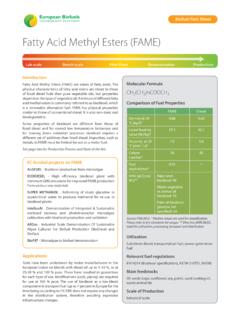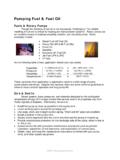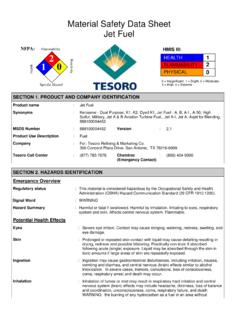Transcription of Hydrotreated Vegetable Oil (HVO) as a Renewable Diesel ...
1 2008-01-2500. Hydrotreated Vegetable Oil (HVO) as a Renewable Diesel fuel : Trade-off between NOx, Particulate Emission, and fuel Consumption of a Heavy Duty Engine Hannu Aatola, Martti Larmi, Teemu Sarjovaara Helsinki University of Technology Seppo Mikkonen Neste Oil Copyright 2008 SAE International ABSTRACT In addition to the fuel requirements set by legislation and fuel standards, fit for purpose has risen as an essential Hydrotreating of Vegetable oils or animal fats is an alter- requirement for fuels. Thus the addition of certain bio native process to esterification for producing biobased components is opposed as they are seen to reduce fuel Diesel fuels. Hydrotreated products are also called re- quality from the point of view of engines, engine cleanli- newable Diesel fuels.
2 Ness, cold operability, emission control systems, or regu- lated and unregulated emissions. fuel requirements are Hydrotreated Vegetable oils (HVO) do not have the detri- in fact becoming more stringent due to new regulations mental effects of ester-type biodiesel fuels, like in- for exhaust emissions, fuel economy, and on-board diag- creased NOx emission, deposit formation, storage stabi- nostics. The mileage requirements for emission control lity problems, more rapid aging of engine oil or poor cold are also being extended. properties. HVOs are straight chain paraffinic hydrocar- bons that are free of aromatics, oxygen and sulfur and fuel distributors must also take into consideration the have high cetane numbers. storage stability and water tolerance when introducing biofuels.
3 Dedicated solutions that are not compatible with In this paper, NOx particulate emission trade-off and the existing fuel logistics involve significant extra costs. NOx fuel consumption trade-off are studied using differ- ent fuel injection timings in a turbocharged charge air cooled common rail heavy duty Diesel engine. Tested fuels were sulfur free Diesel fuel , neat HVO, and a 30% HVO Hydrotreated Vegetable OIL. HVO + 70% Diesel fuel blend. Hydrotreating of Vegetable oils is a modern way to pro- The study shows that there is potential for optimizing duce very high-quality biobased Diesel fuels without com- engine settings together with enhanced fuel composition. promising fuel logistics, engines, exhaust aftertreatment HVO could be used in optimized low emission Diesel devices, or exhaust emissions.
4 These fuels are now also power trains in captive fleet applications like city buses, referred to as Renewable Diesel fuels instead of bio- indoor fork-lift trucks, or mine vehicles. Diesel which is reserved for the fatty acid methyl esters (FAME). Chemically Hydrotreated Vegetable oils (HVOs) are mix- INTRODUCTION tures of paraffinic hydrocarbons and are free of sulfur and aromatics. Cold properties of HVO can be adjusted Vehicle owners in the developed countries have had the to meet the local requirements by adjusting the severity privilege of using high-quality fuels: ash free fuels with of the process or by additional catalytic processing. Ce- ultra-low or zero sulfur content and which are free of tane number of HVO is very high, and other properties heavy fractions.
5 For engines and emission control sys- are very similar to the gas-to-liquid (GTL) and biomass- tems, this has resulted in longer life times, fewer repairs, to-liquid (BTL) Diesel fuels produced by Fischer-Tropsch less maintenance and extended oil-change intervals (FT) synthesis (see Table 1 and Table 2). compared to the situation a decade or more ago. Since HVOs are hydrocarbons, they meet conventional Diesel fuel requirements (EN 590, ASTM D 975, World- wide fuel Charter category 4) except for low limit of den- compared with spark ignition engines is also taken into sity in some specifications. The FAME ester specifica- account, one liter or gallon of HVO can power a vehicle tions (EN 14214, ASTM D 6751) do not apply for HVO.
6 About double the distance compared to an ethanol based fuel such as E85. The lower heating value of HVO ( ) is sub- stantially higher than that of ethanol ( ). When the better efficiency of compression ignition engines Table 1. Typical properties of HVO, European EN 590:2004 Diesel fuel , GTL and FAME. [1]. EN 590 FAME. HVO (summer GTL (from rape grade) seed oil). Density at 15 C (kg/m ). 3. 775 .. 785 835 770 .. 785 885. Viscosity at 40 C (mm /s). 2.. Cetane number 80 .. 99 53 73 .. 81 51. Distillation range ( C) 180 .. 320 180 .. 360 190 .. 330 350 .. 370. Cloud point ( C) 5 .. 25 5 0 .. 25 5. Heating value, lower (MJ/kg) Heating value, lower (MJ/l) Total aromatics (wt-%) 0 30 0 0. (1). Polyaromatics (wt-%) 0 4 0 0. Oxygen content (wt-%) 0 0 0 11.
7 Sulfur content (mg/kg) < 10 < 10 < 10 < 10. (2) (2) (2). Lubricity HFRR at 60 C ( m) < 460 < 460 < 460 < 460. Storage stability Good Good Good Very challenging (1). European definition including di- and tri+ -aromatics (2). With lubricity additive Table 2. Different technologies for biobased Diesel fuels. [1]. Large scale Process Product Feedstocks: Product Production production Volume availability quality plant and price investments Biodiesel 1995 Esterification Ester - - +. FAME. Renewable Diesel 2007 Hydrotreating CnH2n+2 + +++ - HVO. Gasification + Renewable Diesel 2015 Fischer-Tropsch CnH2n+2 +++ +++ --- FT-BTL. CnH2n+2 is a general formula for paraffinic hydrocarbons. + sign indicates benefit, - sign indicates disadvantage The quality of FAME is known to depend on the proper- In the HVO production process, hydrogen is used to ties of the feedstock used and this limits what feedstocks remove the oxygen from the triglyceride ( Vegetable oil).
8 May be used in cold climates. HVOs can be produced and integration to an existing oil refinery is preferred for from many kind of Vegetable oil without compromising small plants. Stand alone units may become competitive fuel quality. Existing farm based feedstocks such as as scale increases. Additional chemicals, like methanol rapeseed, sunflower, and soybean oil can be used, as for FAME-production, are not needed. HVO production well as palm oil. However, as these feedstocks compete process does not produce any glycerol as a side product. with food production, alternative non-food oils such as LPG produced as a side product is used on site to fulfill jatropha and algae oil must be available in the future in the heat and energy requirements (see Figure 1).
9 Large cost-effective volumes in order to be able to replace a significant portion of fossil based Diesel . Waste The first commercial scale HVO plant with a capacity of animal fats can also be used as a feedstock for HVO 170 000 tons per year (3 800bbl per day) was started up process. in summer 2007 at Neste Oil's Porvoo oil refinery in Fin- land. This technology, branded NExBTL , is based on a USE OF BIOCOMPONENTS IN Diesel fuel . separate unit at an oil refinery site while at the same time using existing logistics, quality-control laboratories, and In principle, biobased Diesel fuel component can be used energy plant. A separate unit like this can be optimized in three ways: and run without risking the refinery units, which may be a problem if bio-oils are fed into existing refinery units as 1.
10 To add a couple percent of biocomponent into Diesel blended with fossil feeds. fuels. This is a common approach with ester-type biodiesel fuels (FAME), and the amount is currently limited to maximum 5vol-% by the EN 590:2004. standard. Higher amounts, like 7%, 10% or even 30%, are considered but they need extra precautions because of fuel stability, engine oil dilution, and Hydrotreating unit deposit formation in fuel injection systems. integrated to oil refinery using existing 2. To blend tens of percents of biocomponent into die- Bio oils logistics Feed tank sel fuels. This is possible with Hydrotreated vege- energy, hydrogen quality control lab table oils (HVO) without compromising fuel quality, Pretreatment etc. facilities exhaust emissions and engine operation.









